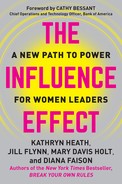APPENDIX B
Methodology
The premises and data in this book are based on (1) our 2015–16 “Gender Perceptions of Office Politics” survey; (2) follow-up interviews with forty-four executives; and (3) an analysis of our database of 360-degree feedback reports.
1. “Gender Perceptions of Office Politics” Survey
Summary of the Survey
Do gender differences exist in the following areas?
- Description of office politics
- Like or dislike of office politics
- Perceived competency in political maneuvering
- The importance of political skills in relation to career success or advancement
- Perceptions of gender differences in corporate politics and political maneuvering
- How often women and men engage in office politics
Summary of the Findings
- Respondents in this study generally had a negative view of office politics.
- Respondents generally viewed office politics as difficult or time consuming.
- Respondents generally had high perceptions of their political maneuvering skills.
- Although both genders viewed political skills as important, females tended to agree more strongly that political skills are essential to their career-related success.
- Although both genders acknowledge that gender differences exist in the realm of office politics, women feel more strongly about them than men do.
- Women were more likely than men to indicate agreement with the assertion that men are better than women at political maneuvering.
- Women in this study reported that they engage in office politics more often than did men in this study.
Participants
- In total, there were 134 survey participants, including 87 females and 47 males in America. Of these participants,
- 20.7 percent of the women and 29.8 percent of the men were in the C-suite;
- 57.5 percent of the women and 46.8 percent of the men were at the executive level;
- 13 percent of the women and 8 percent of the men were in middle management;
- 6 percent of the women and 3 percent of the men were entrepreneurs or individual contributors.
- Participants were executives at companies including Duke Energy, Deloitte, Razorfish Health, Calvert Investments, Ingersoll Rand, Booz Allen Hamilton, American Express, Carolinas HealthCare System, Leidos, AIG, Bank of America, Fifth Third Bank, IBM, Jones Lang LaSalle, and Wells Fargo.
Analysis Procedure
- Chi-square tests were used to assess differences by gender.
- The chi-square determines whether we can conclude with 95 percent confidence that there is a relationship between participants’ gender and their responses to the survey questions.
2. Additional Research
We conducted in-depth phone interviews with forty-four executive-level men and women in American corporations.
3. Database Analysis
We utilized our proprietary database of 7,500 360-degree feedback reports on top women executives in America.
..................Content has been hidden....................
You can't read the all page of ebook, please click here login for view all page.
